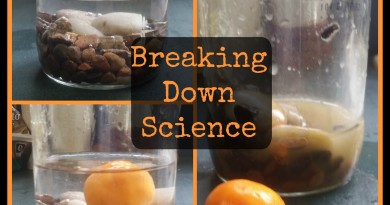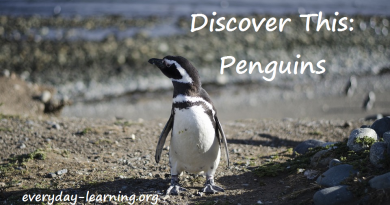Discovering Science: Angel Wings and Waterfowl

Our local nature center built a brand new waterfowl exhibit, even though the nearest lake is a mile up the mountain. (Okay, it’s a really steep hill with lots of trees growing on it, but it feels like a mountain somedays.)
Not until fingers started pointing through the wire fence did I slow down to take notice of what was in the pen. Clearly, something was wrong with the geese. At first glance, it looked as though the birds were walking around with their wings sticking out – kind of like there were doing a mating ritual.
On closer look, we saw that the wings were permanently bent in a painfully awkward position away from the bird’s body. Then we saw the sign.

Feeding bread to ducks and geese is a major No-No. In the past, I had heard people say you shouldn’t feed wild animals, but I always thought it was because it made them dependent on humans and they would lose their natural ability to find food for themselves.
Even though we think of bread as a food high in carbohydrates, enriched bread has more protein in it than a baby duck or gosling needs. As biologists from Michigan State explain – when birds eat too much bread, especially when they’re still young, their wings grow too fast for the rest of their body. The young bird’s body cannot support the weight, so the wings become twisted and deformed. Twisted wings can’t fly, which means the birds can’t look for food, migrate, or even escape from predators.
Stumbling on this bird exhibit opened up so many more questions.
- Birds with Angel Wing cannot fly. Can you name other naturally flightless birds? Think off the top of your head and you’ll guess penguin and ostrich, but did you know there are over 40 types of flightless birds found in the world today? As you read about the birds, study their physical features and make a chart. Do the birds have anything in common that allows them defend themselves against predators? Look at their feet or talons – their beak – their size – other methods for moving – even their behavior pattern. Don’t forget to look at habitats. Do most flightless birds live on a certain continent or are they spread across the world?
While you’re at comparing and contrasting birds, take a look at their diets. Obviously, bread is not good for birds because it’s high in protein; but what should birds eat? Some birds, like eagles, eat fish – but isn’t that high in protein, also? While a trip to the library or a good keyword search will help you find answers to your questions, you can also reach out and ask an Aviary Expert if you get stumped.
- Check out this short animation that explains how birds fly with a great analogy using a boat moving down a river. If you want to learn more about how birds fly, here’s some free middle school level lesson plans on bird flight.
- Be a Citizen Scientist with Cornell University’s Lab of Ornithology. Pick from one of 6 ongoing projects, like Project FeederWatch and Nest Watch, and add your bird data to real research. If you visit the Cornell bird link, be sure to click around their site. You’ll find bird cams and all kinds of free resources to help you build birdhouses and keep learning about birds of all types.
- It’s commonly believed that most birds lost the ability to fly because they weren’t being chased by predators. Eventually, a special bone in their chest, that is used to hold wing muscles in place, devolved from their skeletons.
Now, here’s the interesting tidbit. In February 2015, the Smithsonian Magazine reported that scientists have found evidence that evolution can be reversed. Bones found in dinosaur fossil remains (but not found in animals descended from dinos) have been found, again, in the embryos of some modern-day birds.
Evolutionary biology is an advanced topic. But, if you have a kid who is really into dinosaurs or finds birds kind of cool, then you should first check out the University of California’s What Did T-Rex Taste Like free online learning module. Trust me when I say you’ll be going down a very long and interesting rabbit hole learning about the evolutionary link between dinosaurs and birds.
 |
 |
 |





